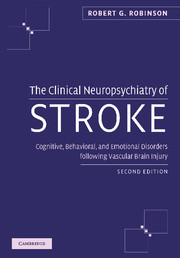 The Clinical Neuropsychiatry of Stroke
The Clinical Neuropsychiatry of Stroke Book contents
- Frontmatter
- Contents
- Preface
- Part I Introduction
- Part II Poststroke depression
- 5 Diagnosis of depression
- 6 Prevalence of depressive disorders
- 7 Phenomenology and specificity of depressive symptoms
- 8 Natural course of depression
- 9 Delayed-onset depression
- 10 Relationship to lesion location
- 11 Relationship of depression to cerebral dominance and structural asymmetries
- 12 Relationship of depression to bilateral hemisphere brain injury
- 13 Relationship of depression to physical impairment
- 14 Relationship to cognitive impairment and treatment
- 15 Relationship of aphasia to depression
- 16 Relationship of depression to social functioning
- 17 Relationship to premorbid risk factors
- 18 Mortality and treatment
- 19 Suicidal thoughts and plans
- 20 Biological markers
- 21 Mechanisms of poststroke depression
- 22 Treatment of poststroke depression
- 23 Prevention of poststroke depression
- Part III Poststroke mania
- Part IV Poststroke anxiety disorders
- Part V Other poststroke disorders
- Index
12 - Relationship of depression to bilateral hemisphere brain injury
from Part II - Poststroke depression
Published online by Cambridge University Press: 01 October 2009
- Frontmatter
- Contents
- Preface
- Part I Introduction
- Part II Poststroke depression
- 5 Diagnosis of depression
- 6 Prevalence of depressive disorders
- 7 Phenomenology and specificity of depressive symptoms
- 8 Natural course of depression
- 9 Delayed-onset depression
- 10 Relationship to lesion location
- 11 Relationship of depression to cerebral dominance and structural asymmetries
- 12 Relationship of depression to bilateral hemisphere brain injury
- 13 Relationship of depression to physical impairment
- 14 Relationship to cognitive impairment and treatment
- 15 Relationship of aphasia to depression
- 16 Relationship of depression to social functioning
- 17 Relationship to premorbid risk factors
- 18 Mortality and treatment
- 19 Suicidal thoughts and plans
- 20 Biological markers
- 21 Mechanisms of poststroke depression
- 22 Treatment of poststroke depression
- 23 Prevention of poststroke depression
- Part III Poststroke mania
- Part IV Poststroke anxiety disorders
- Part V Other poststroke disorders
- Index
Summary
The role of each cerebral hemisphere in emotion regulation has been a topic of speculation and experimental investigation for many years. Flor-Henry (1979), for example, suggested a complex model for the organization of mood. He proposed that the neural substrate for both normal and abnormal mood was predominantly in the non-dominant hemisphere but with bilateral regulation. Thus, according to this hypothesis, euphoria results when the dominant hemisphere no longer receives transcallosal neural inhibition from the non-dominant hemisphere and depression results when the non-dominant hemisphere is released from inhibition by dysfunction in dominant hemisphere. Tucker (1981) has also suggested that the neural substrate for emotion is predominantly in the non-dominant hemisphere. Rather than emphasizing a contralateral release, however, he has suggested ipsilateral release with non-dominant dysfunction leading to positive mood and dominant hemisphere dysfunction manifested as anxious, negative mood. Davidson (1998) suggested that frontal asymmetries recorded by electroencephalography (EEG) in patients with depression (i.e., left frontal inactivation) may reflect deficits in motivation which are independent of current mental state. According to this hypothesis, depressive symptoms emerge based on the cumulative effects of chronic left frontal inactivation and the consequent inability to experience pleasure (Davidson et al. 2001). Finally, Kinsbourne and Bemporad (1984) emphasized the integrated functions of the left frontal and right posterior brain areas in mood and suggested that dysfunction in both areas may be involved in depression.
- Type
- Chapter
- Information
- The Clinical Neuropsychiatry of StrokeCognitive, Behavioral and Emotional Disorders following Vascular Brain Injury, pp. 120 - 124Publisher: Cambridge University PressPrint publication year: 2006


